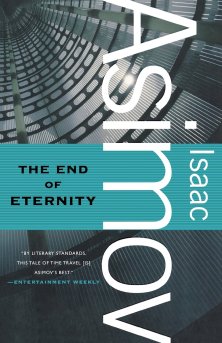-Spoilers for the Foundation universe. A full index of novels can be found here–

Publisher: Panther
Genre: Time Travel
Pages: 191
Publication Date: 1955
Verdict: 4/5
Eternity exists in all times and beyond time. A society of intellectuals sworn to the preservation of the human race. But when you can manipulate reality, how can any man resist the temptation to change it in his favour? And what consequences might there be for such an act . . ?
The first time I read The End of Eternity, I wasn’t that impressed. I’ve always preferred my SF set in space, with massive worldbuilding. Coming back a few years later, this claustrophobic tale is much more enjoyable. Enough time had passed that I’d forgotten some of the twists and turns the story takes, and so I was just as gripped as a fresh reader could hope to be.
This novel has all the hallmarks you’d expect from an Asimov tale. Tight prose, a championing of intellect over brute force, and a well-plotted romp to boot. It’s also a lot more character-driven than a lot of Asimov’s more famous works. Andrew Harlan is an interesting and likable protagonist, and the mysterious Noys Lambent a fascinating partner for him. Their relationship is what drives the novel and, while it’s not alway a convincing one, that relationship is certainly interesting to read.
Taking place largely inside a single building – several versions of the same building in fact – this book generally feels closer to Asimov’s crime mysteries than it does to a lot of his more science fictional work. There’s little sense of the world(s) outside of Eternity, which is the novel’s only real weakness. That being said, the travel between centuries, and the simplicity of phrases like ‘Upwhen’ and ‘physioyear’ lend a tangible sense of otherness to even the most mundane tasks.
In terms of the larger Foundation universe, this book is something of an outlier. Indeed, it would be easy to say that it’s not part of the series at all. However, the role of Eternity in shaping a universe that could one day lead to the one shown in the Galactic Empire and Foundation eras is plain to see. There are a few other clues too. Similar pieces of technology and the like, although this may be a case of recycled ideas rather than universe-building. Nevertheless, it does lend a certain level of stability to the universe in question.
This is one of two Asimov novels to centre around time travel, and the only one that goes into any real detail about how the process works. While the science behind temporal travel is of course nonsense, it’s convincing nonsense, with all the scientific rigour you’d expect of the Good Doctor. Intelligence is taken seriously, celebrated even when it is not put to the best use. That, to me, is what makes Asimov’s stories so great. When his characters resort to violence, it is almost always their last resort. We’ll be seeing more of this as the reread goes on, but it’s good to see it in evidence so soon out the gates.
Though not without its faults, The End of Eternity works both as a standalone story, and as a set-up for the larger Foundation universe.

